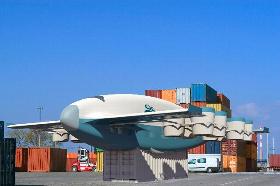

A prototype scale-model of the unmanned cargo aircraft called the Versatile Vehicle (VV)-Plane, designed to compete with road transport, is to fly on 26 September at London Ashford Airport, also known as Lydd Airport.
The scale-model will have a one metre wingspan and will carry five kilogrammes. This prototype will be used to test the flight control system. The actual VV-Plane will be 15 metres long with a 15 metre wingspan. Its designers say it will be able to carry 30 tonnes, flying at up to 173.7 knots (321.6 kilometres per hour) and taking off and landing vertically. The VV-Plane is designed to compete against lorries in developing countries where road transport is difficult and slow due to bad and impassable roads.
Like a lorry, the VV-Plane would carry an industry standard Twenty foot Equivalent Unit (TEU) container. The VV-Plane is being developed by the company 4×4 Aviation, based at Lydd airport. The company’s analysis is that while lorries can cover up to 550 miles (885.1 kilometres) per day, the VV-Plane has an 800 kilometre range and can cover 3,218.6 kilometres with multiple trips and travelling at 173.7 knots.
Thorsten Reinhardt is the founder and managing director of 4×4 Aviation. He tells Air Cargo Week: “We are in discussion with a couple of countries to licence the fabrication of our technology so they can manufacture it for their own demand.”
The VV-Plane lifts off vertically using four clusters of four electrically powered ducted fans. The fans use 4×4 Aviation’s patented gimbal technology to move the four groups of ducts to a horizontal position to produce the thrust for acceleration after take-off. The aircraft has a horizontal stabiliser at the back and a forewing near the nose of the aircraft. The fans receive power from an electrical system that Reinhardt calls a, “combined cycle system”.
Most of the electrical power is produced by a diesel generator. Fifty five per cent of the electricity is generated from that, with the remaining 45 per cent coming from what Reinhardt calls, “gas efficiency,” and the reuse of the generator’s waste heat through steam.










